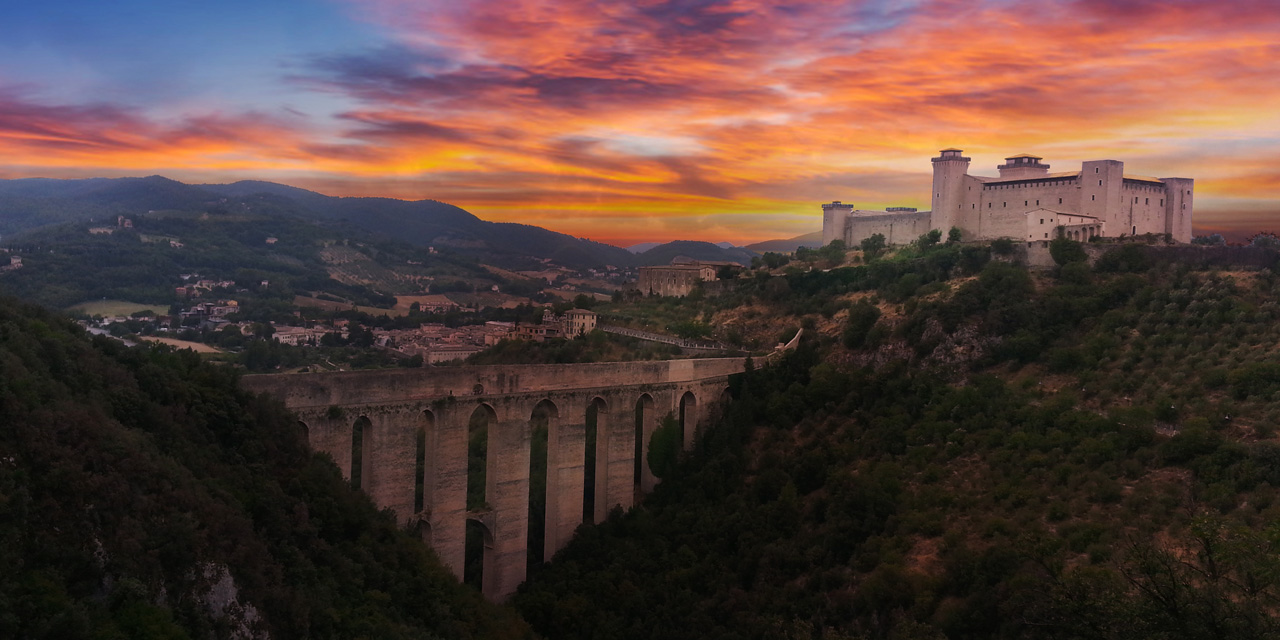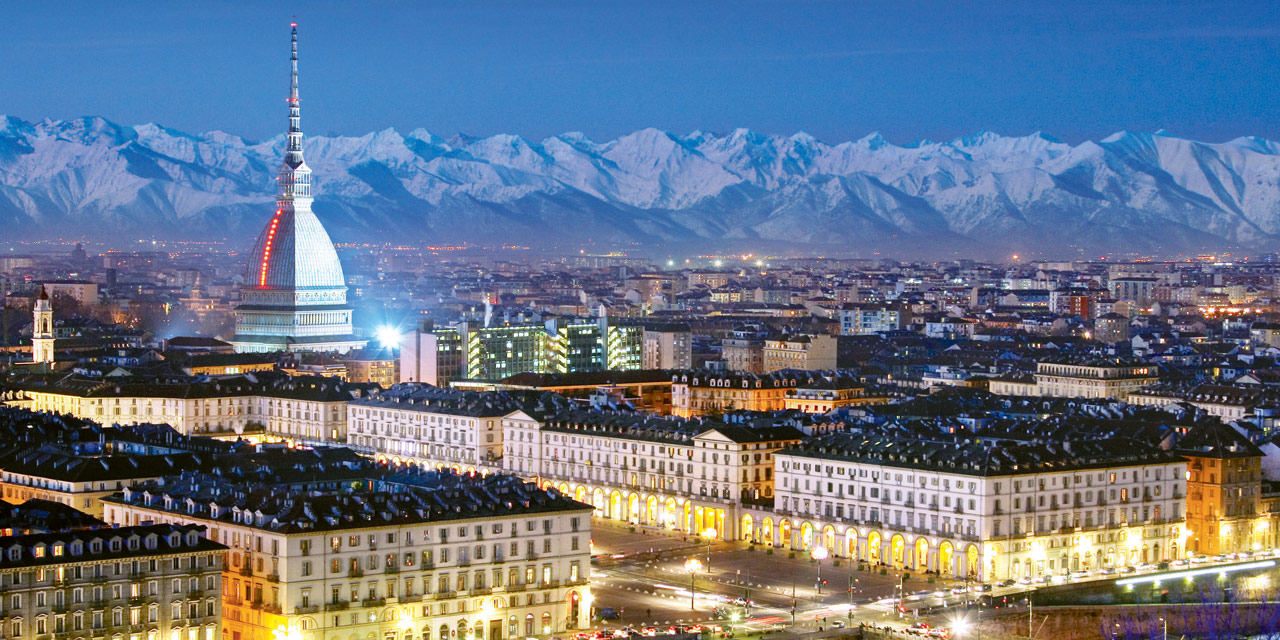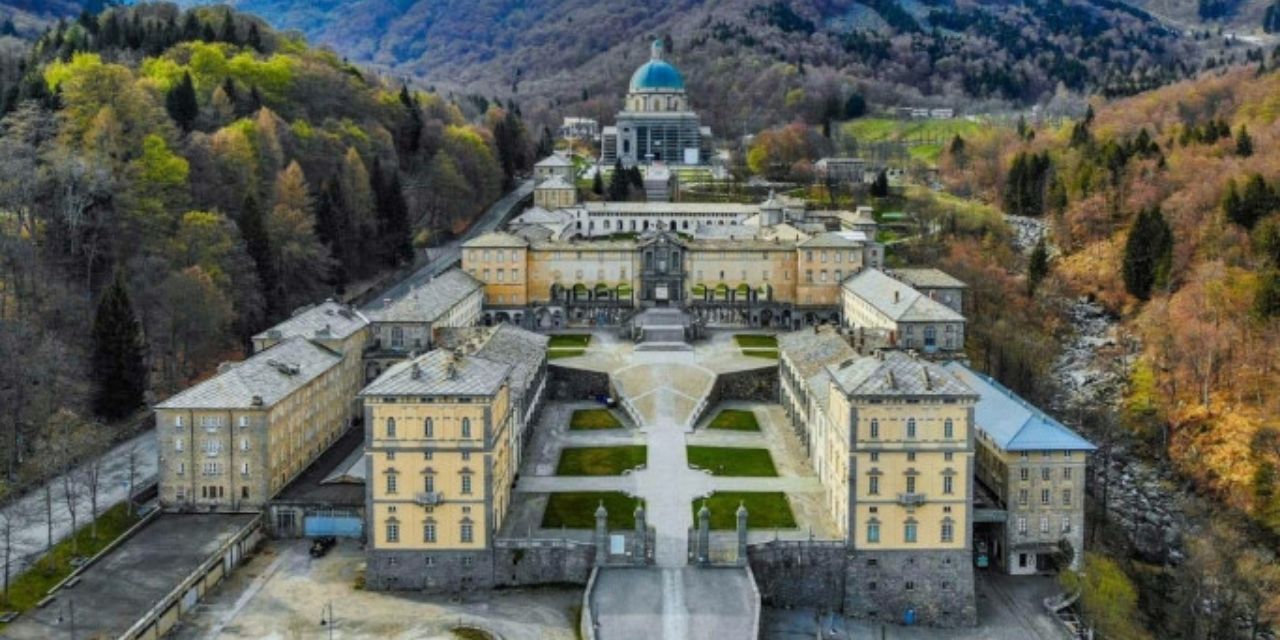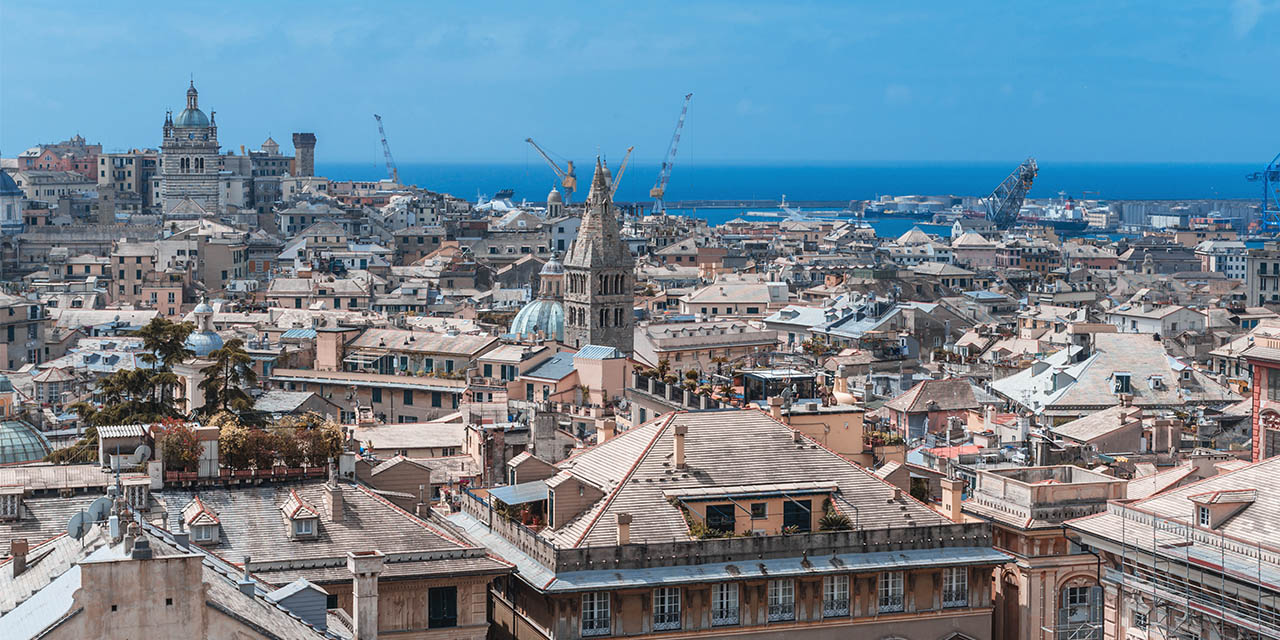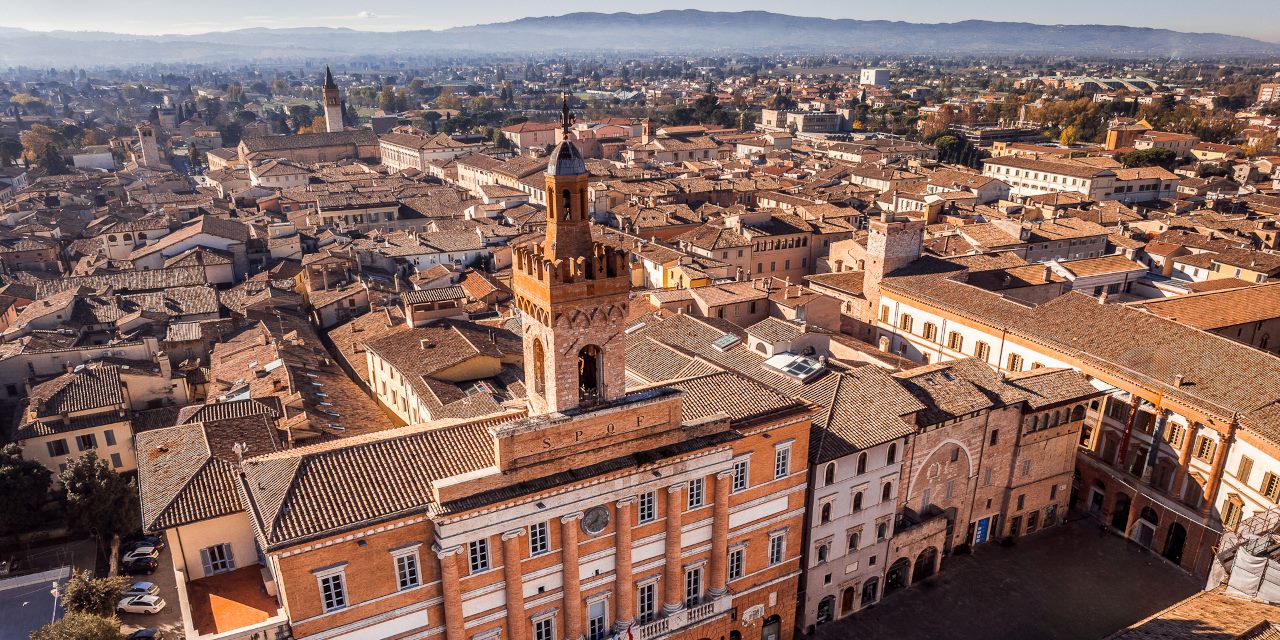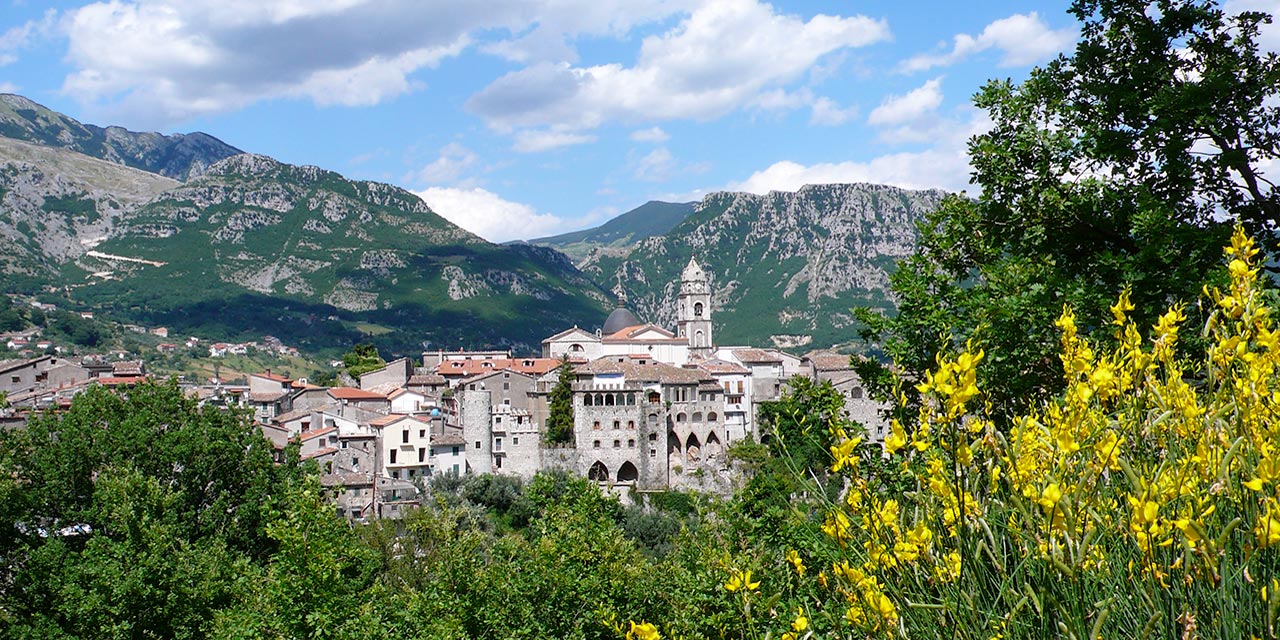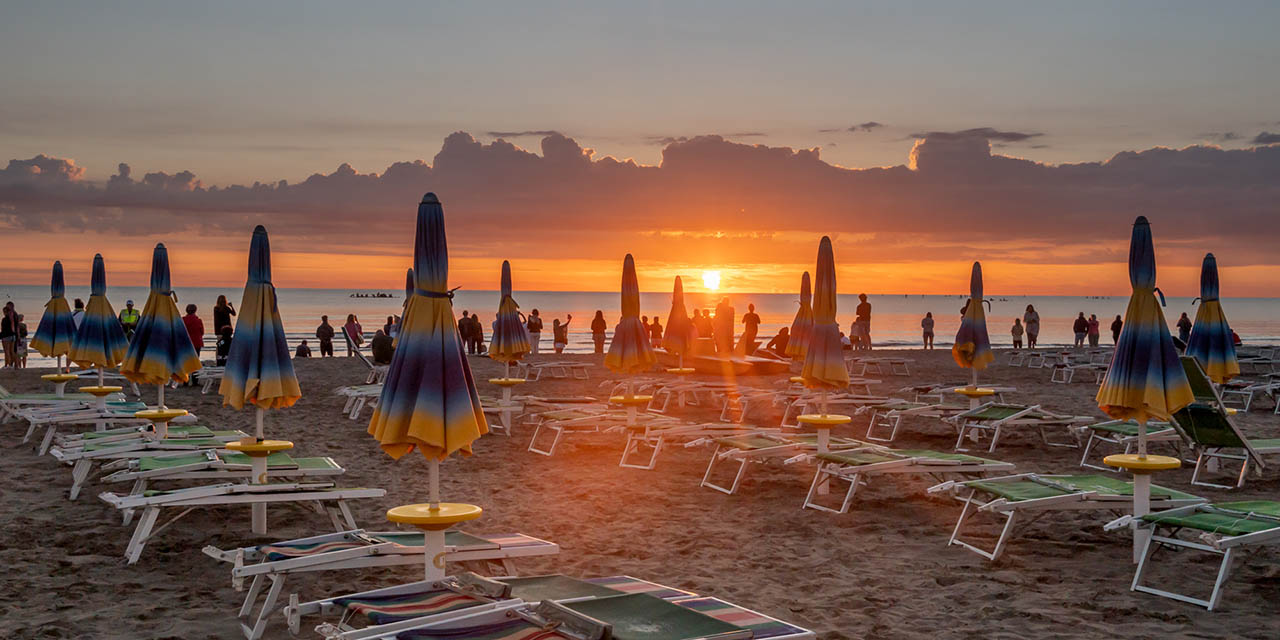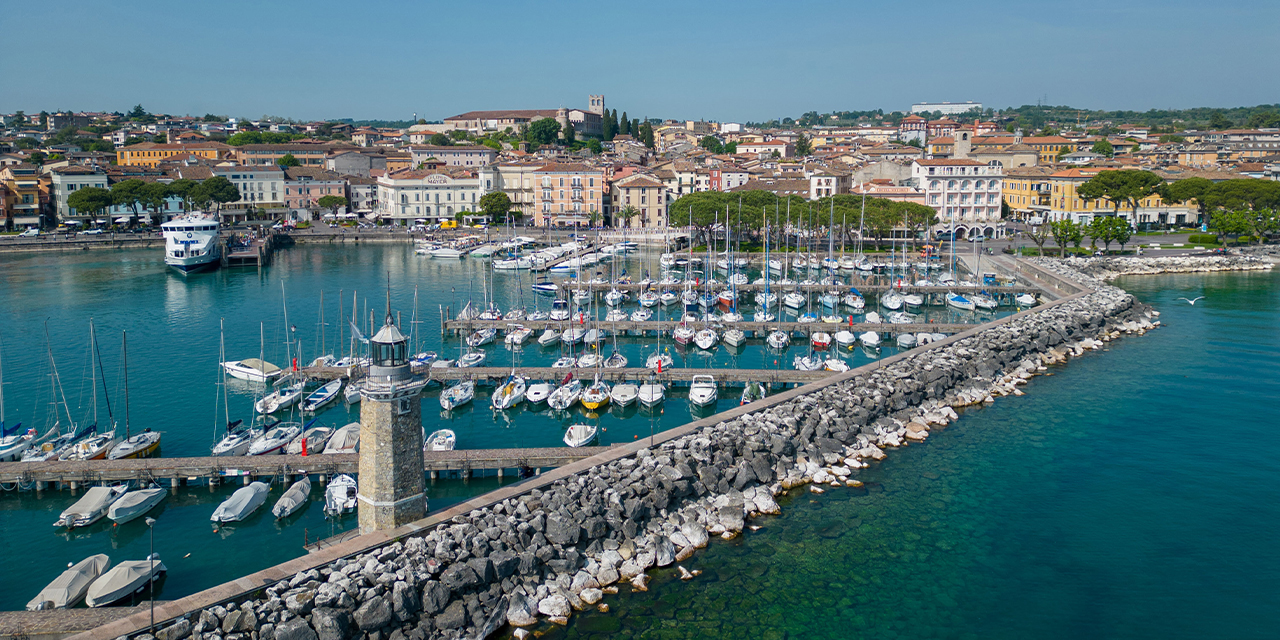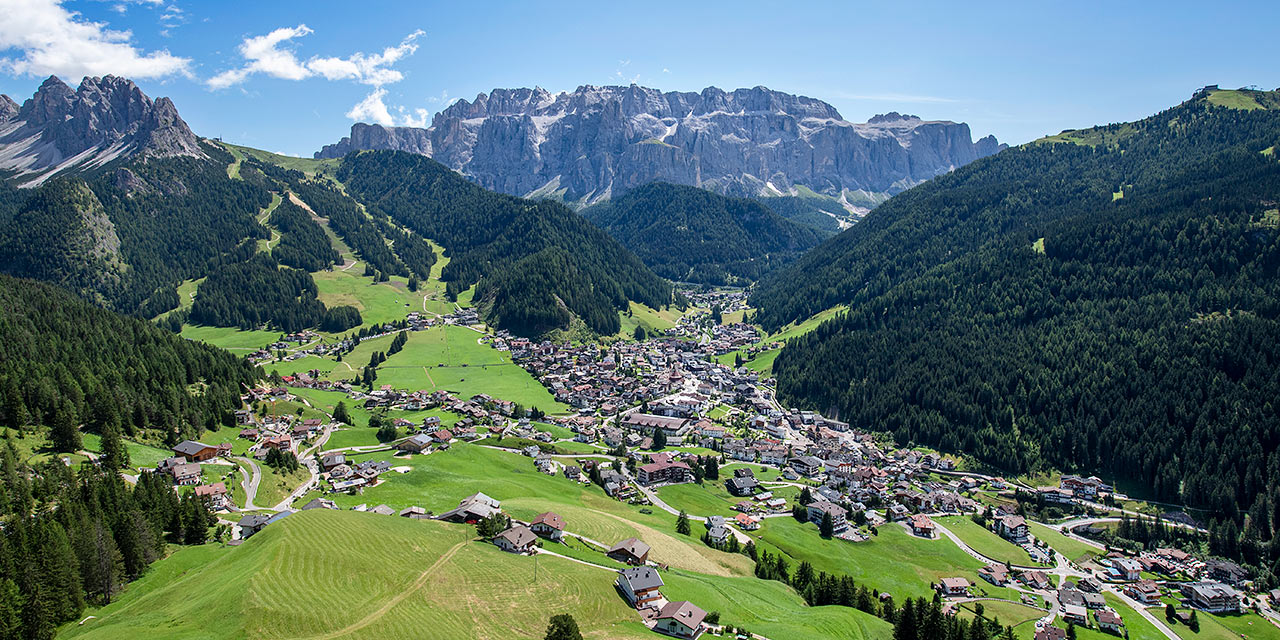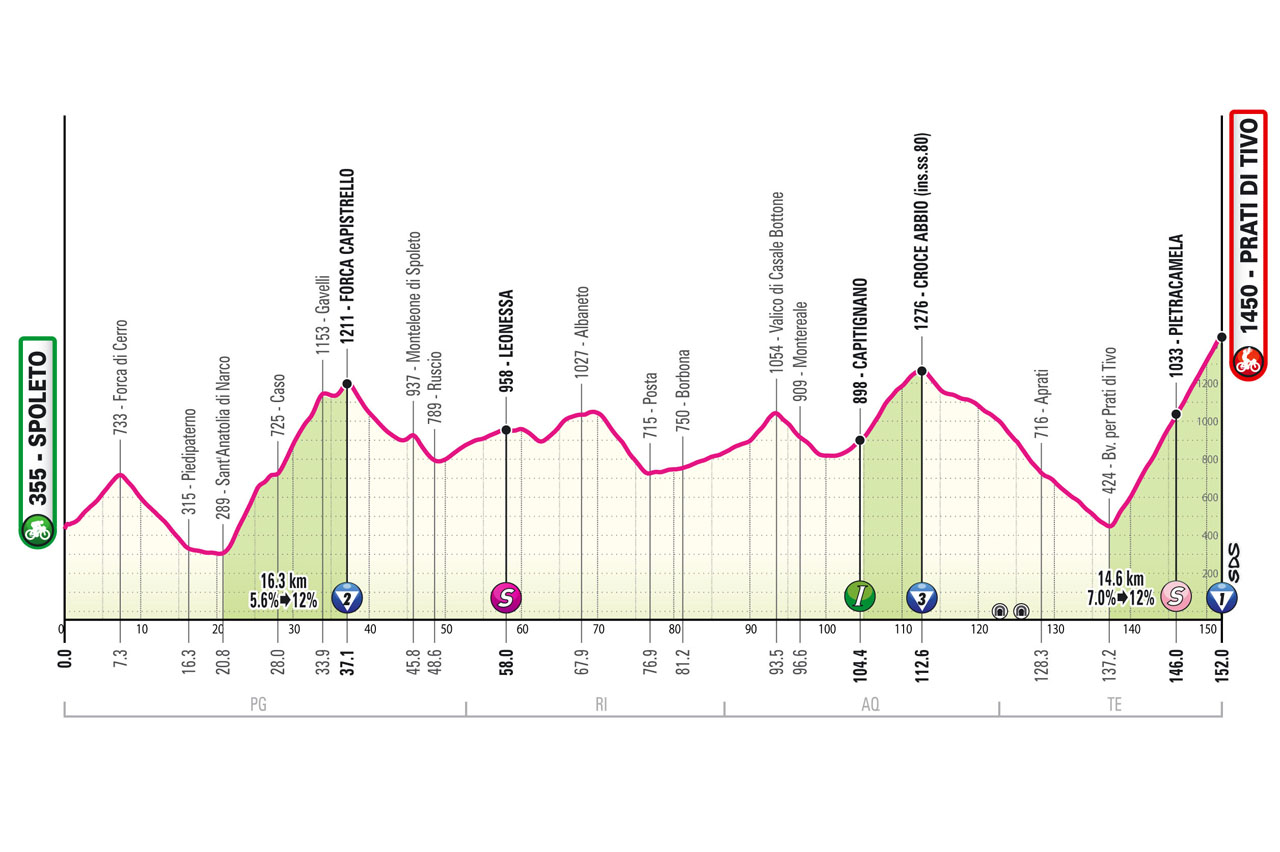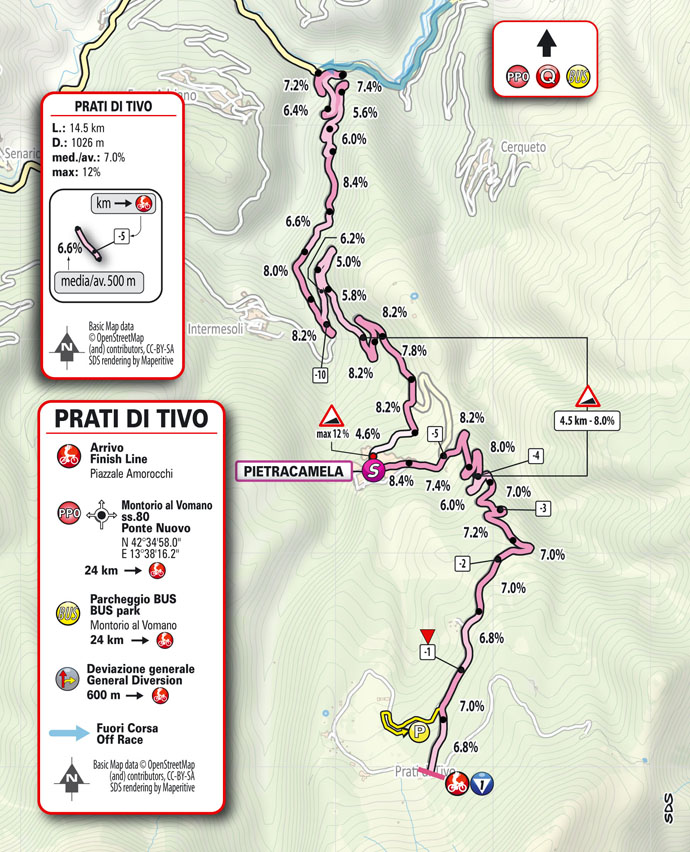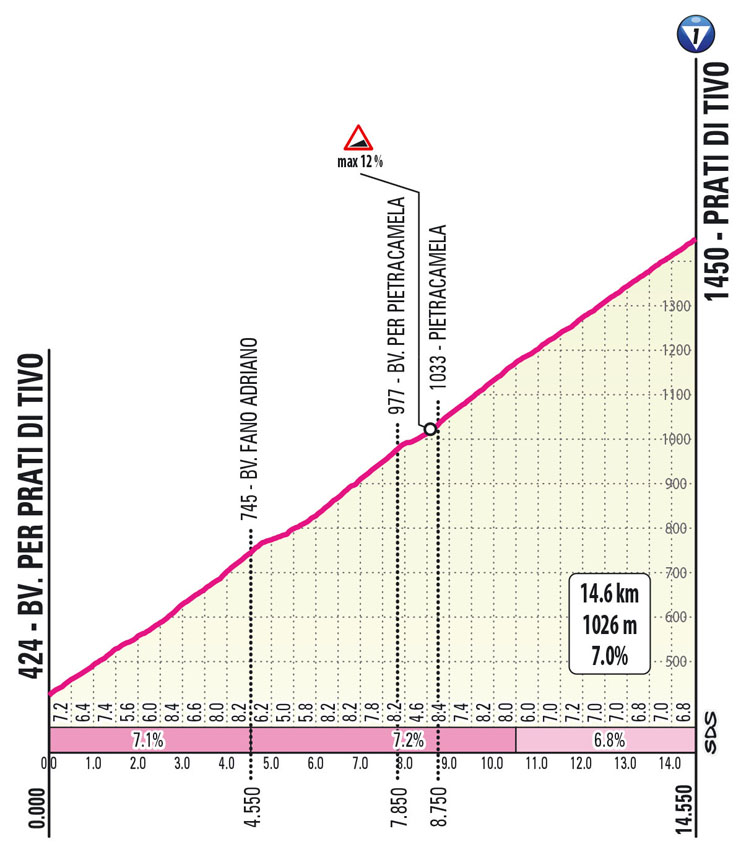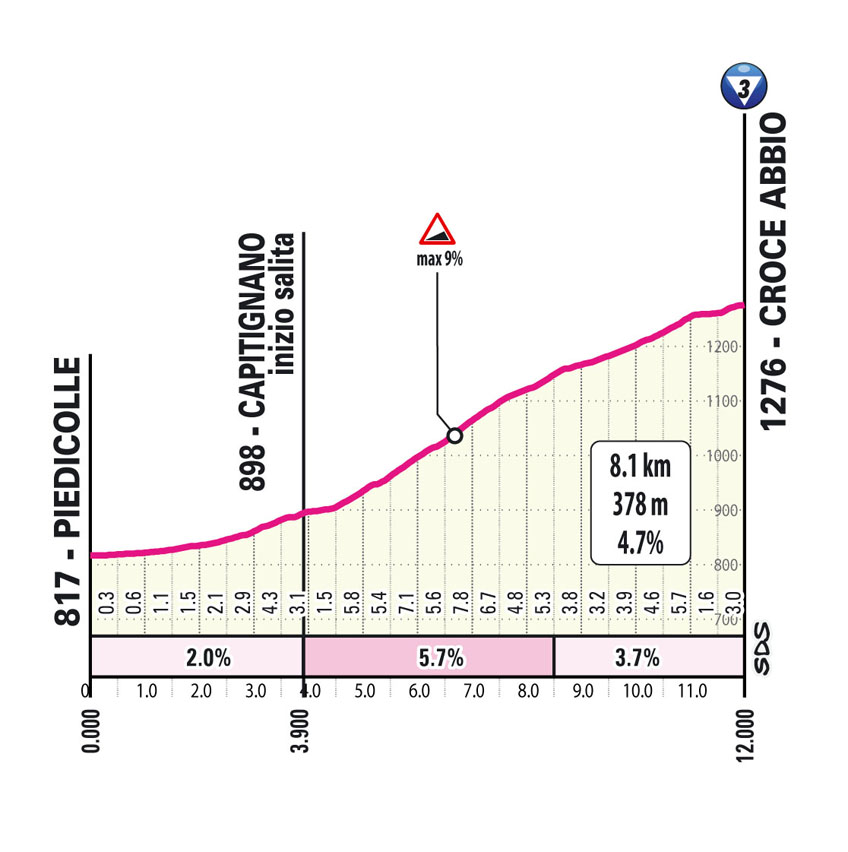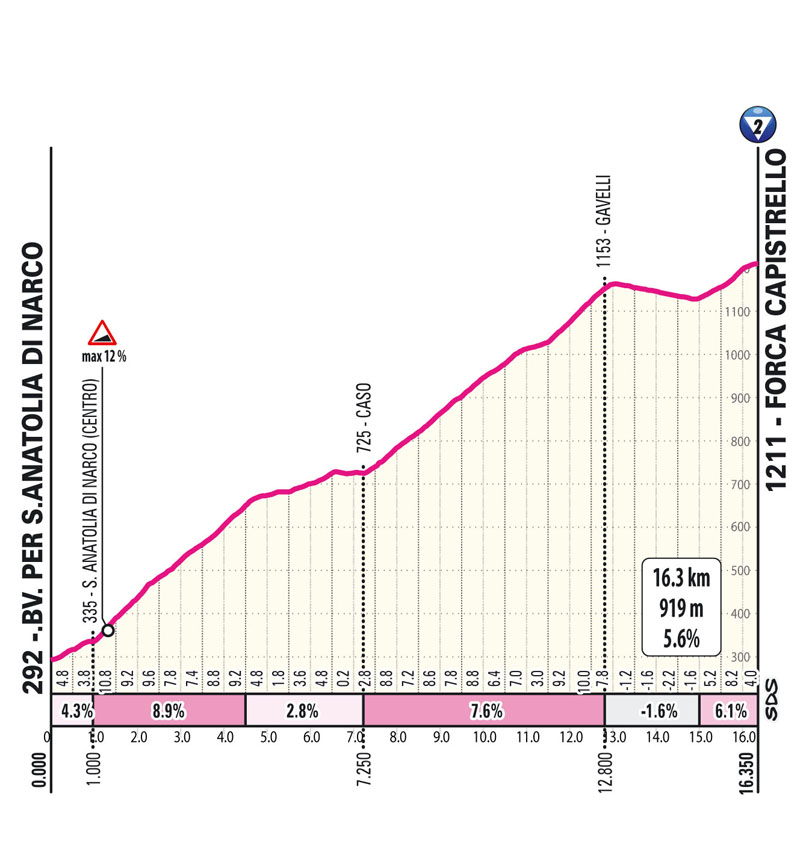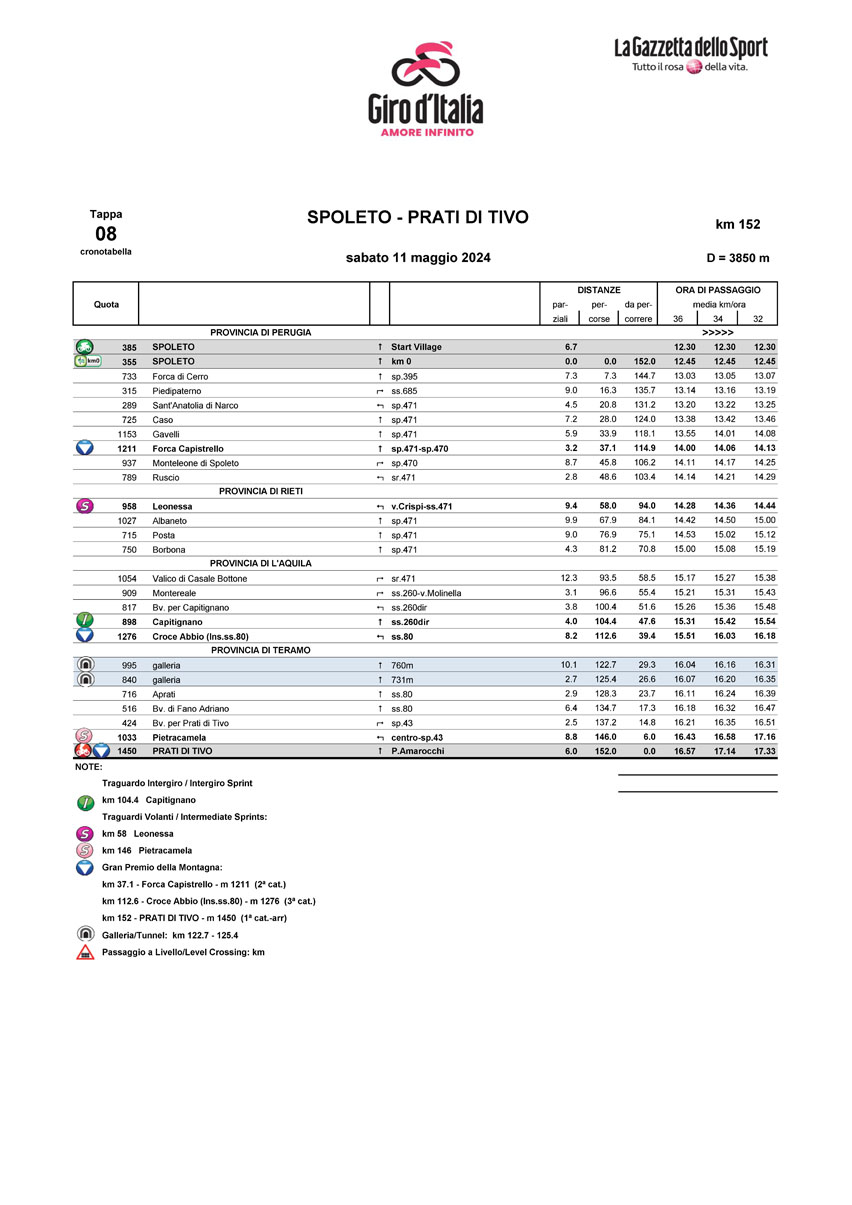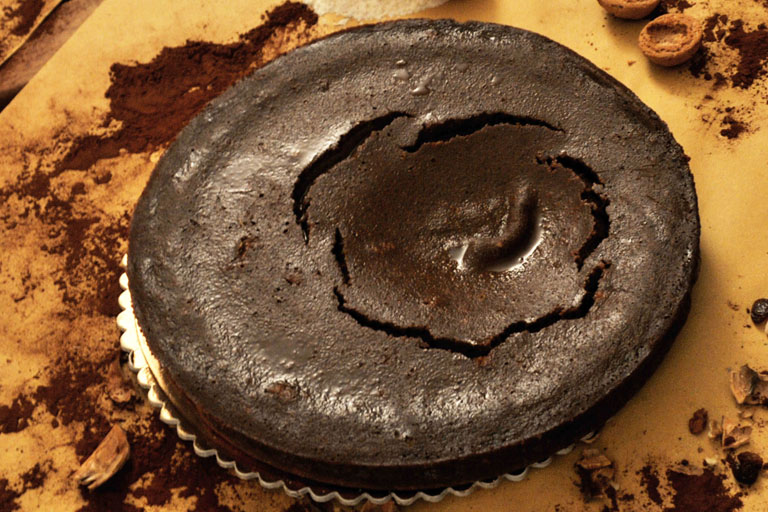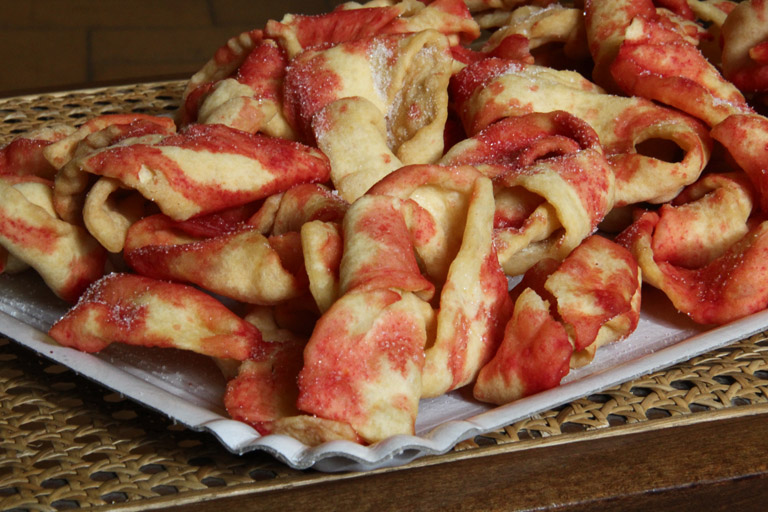profile
map
technical info
Short stage with no flat ground to play with and plenty of elevation gain. Just after the start, the pink caravan climbs Forca di Cerro, followed by Forca Capistrello, which is over 16 km long. The peloton will then skim over the Terminillo massif to reach Capitignano, with continuous ups and downs leading to the western slope of the Capannelle Pass. The climb ends a short distance from the pass at Croce Abbio, where the 30 km descent begins, leading to the foot of the final climb. The descent is characterised by numerous bends and two long, well-lit tunnels. The finish asperity to Prati di Tivo adds 14 kilometres at 7% to the mix.
Last kilometres
The final climb is 14.5 km long at 7% average with peaks of up to 12%. It counts 22 hairpin bends and has the steepest gradients in the first part, with peaks around the village of Pietracamela, where the intermediate sprint is located. The last three kilometres are at 7%. The final straight is approximately 300 m long and 6 m wide on an asphalt surface.
start / finish
climb detail
final kilometres
itinerary timetable
tourist info
Host city:
Spoleto
Overview
The municipality of Spoleto is located in the southern part of the Umbrian Valley and enclosed within a large plain (where a lake also once stood). The town developed on the Sant’Elia hill and then continued towards the Monteluco areas and up to the banks of river Tessino.
Food
- Strangozzi (a.k.a. Strengozze or Stringozzi): a local type of pasta of very humble and ancient origins. Strangozzi owe their name to their shape, similar to the leather laces of a shoe, and are slightly thicker noodles than the traditional ones, with a flour-based dough and no eggs. Strangozzi are paired with simple, essential condiments: Spoleto oil first and foremost, but also fresh tomatoes and forest products such as wild asparagus, mushrooms and truffles.
- Crescionda: among the many traditional sweets, Crescionda is undoubtedly the most typical cake of the Spoleto area, despite being rather unknown in the rest of the region. When cut, it is made up of three layers: the first, consisting of macaroons and flour, the second, a light central layer like vanilla pudding, made up of milk and eggs, and the third, dark-coloured layer consisting almost exclusively of chocolate.
- Attorta: once prepared for the main festivities throughout the year, today this cake is maily a Christmas or winter dish. The Attorta, known in other parts of Umbria as ‘rocciata’, is reminiscent of the more Nordic ‘strudel’ and is composed of a coil of pastry twisted on itself, filled with apples and other ingredients including sultanas, pine nuts, walnuts, chocolate and alchermes.
- Castagnole: the dough for Castagnole is made of eggs, sugar, flour and lard, to which honey and mistrà are then added. They are also called sfrappe or fennel. Castagnole get their name from their small, rounded shape, similar to that of chestnuts, and are fried in hot oil and then sprinkled with alchermes. They match perfectly with vin santo.
Points of Interest
- Track of the former Spoleto-Norcia railway: the 51-km railway line from Spoleto to Norcia was inaugurated in 1926 and remained operational until 1968. The line had all the characteristics of a narrow mountain railway and was considered a masterpiece of engineering and environmental integration. The route, surrounded by enchanting natural scenery, has over the years been almost entirely redeveloped and turned into a greenway that can be enjoyed on foot or by bicycle. The route, which allows you to discover the Umbrian Valley through enchanting and little-known locations, has been awarded as the best greenway in Italy.
- Rocca Albornoz: Spoleto’s Rocca Albornoziana stands on top of Colle Sant’Elia, at the highest point of the town. It was built around 1360 as part of the system of fortresses erected by Cardinal Albornoz to defend the territories of the Papal State, in view of the definitive return of the papal seat from Avignon to Rome. It is rectangular in shape, with two large inner courtyards and six towers. The Rocca is currently a museum site and houses the National Museum of the Duchy of Spoleto. Beneath the Rocca stands the impressive Ponte delle Torri, another Spoleto landmark, once an aqueduct. The bridge’s 230-metre-long pedestrian walkway enables visitors to quickly reach Monteluco, a mountain dear to St Francis and the people of Spoleto. It is criss-crossed by trekking paths offering superb views of the city and the Spoleto Valley.
- Piazza Duomo: a splendid view opens up from the top of the steps in Via dell’Arringo over the scenic Piazza Duomo, created in the late Middle Ages by excavating a terrace at the foot of the Sant’Elia hill. To the left of the square is the Teatro Caio Melisso, built in the second half of the 17th century, and the church of S. Maria della Manna d’Oro, dating back to the 16th and 17th centuries. Across the square stands the Cathedral of Santa Maria Assunta, the spiritual centre of the city, dating back to the 12th century. Piazza Duomo is the venue for the final concert of the famous Festival dei Due Mondi, held regularly since 1958 and attracting artists and fans of music, theatre, dance and visual arts. This year, the Festival dei Due Mondi will be held from 28 June to 14 July; the programme for the next edition is available on the official website of the Festival: festivaldispoleto.com
- Palazzo Collicola: Palazzo Collicola is an imposing aristocratic palace built between 1717 and 1730 at the behest of Cardinal Francesco Collicola. Originally, it counted one hundred and ten rooms arranged on four levels, in addition to the rooms in the basement and attics, and overlooked what used to be the family stables, now Piazza Collicola. Palazzo Collicola is currently the seat of the Art Gallery. The Palazzo also houses the Giovanni Carandente Library, a remarkable collection of contemporary art with over thirty thousand volumes that are catalogued and available for consultation. More information available at on the website of Palazzo Collicola.
- Teatro Nuovo “Gian Carlo Menotti”: the New Theatre was built between 1854 and 1864 to a design by the Marchigian engineer Ireneo Aleandri. The theatre is easily accessible via the underground walkway connecting the Posterna car park to the upper part of the historic centre. The town of Spoleto has in fact equipped itself with a modern system of car parks, escalators and moving walkways that allow visitors to leave their vehicles just outside the centre and then move around comfortably on foot.
Prati di Tivo
Overview
Prati di Tivo is a tourist resort in the municipality of Pietracamela (Teramo) located at an altitude of 1,450 metres, at the foot of Gran Sasso d’Italia, which at 2,912 metres is the highest peak in the Apennines. Surrounded by beech and aschiero woods, it is one of the most fascinating natural landscapes in Abruzzo, characterised by a very rich and varied flora with anemones, gentians, orchids and primroses.
Prati di Tivo is a tourist resort that attracts tourists and sportspeople all year round, as it offers visitors a number of customised seasonal services along with a broad variety of hotels. It is the most important site in the Apennines for both winter and summer climbing, and it features hundreds of kilometres of hiking trails for all levels of difficulty. In the winter season, it is a popular destination for ski lovers, and offers the possibility of exciting snowshoe hikes in the marvellous Bosco vetusto dell’Aschiero, a forest which is home to giant centuries-old beech trees. From Prati di Tivo it is possible to reach the Carlo Franchetti Alpine Shelter, located at 2,433 metres above sea level between the majestic peaks of Corno Grande and Corno Piccolo and near the Calderone Glacier, the southernmost glacier in Europe.
Points of Interest
Pietracamela is an ancient village located near the course of the Rio Arno at an altitude of 1,005 metres. The centre, perched on a mountain slope and surmounted by a looming rock, consists of elevated buildings and narrow cobblestone alleys surmounted by small balconies that look out onto belvedere terraces and dominate the Gran Sasso mountain range on one side and the vast panorama of the province of Teramo in the valley on the other.
Entering the small streets of the village among the stone houses, one comes across the ancient church of San Giovanni Battista, built in 1432, containing a wonderful and impressive weight clock mechanism from 1700. Continuing along the narrow streets we reach the Church of San Rocco, built in 1530 and dedicated to the saint during the plague that was raging throughout the peninsula at that time. Close by is also the imposing Church of San Leucio, Pietracamela’s patron saint.
Pietracamela’s peculiarities are undoubtedly the rock paintings by master Guido Montauti (1918-1979), an internationally renowned artist who was a native of this town. This is an open-air museum and a destination for visitors all year round.
Pietracamela is well-known within the Italian mountaineering world, as it gave birth and is still home to Italy’s longest-living mountaineering association, the ‘Aquilotti del Gran Sasso – Alpinisti di Pietracamela’, which will celebrate its 100th anniversary in 2023.
A short distance from Pietracamela is the village of Intermesoli, which also boasts ancient origins and, between the Middle Ages and the Renaissance, was a highly populated centre thanks to wool processing and forestry activities.

